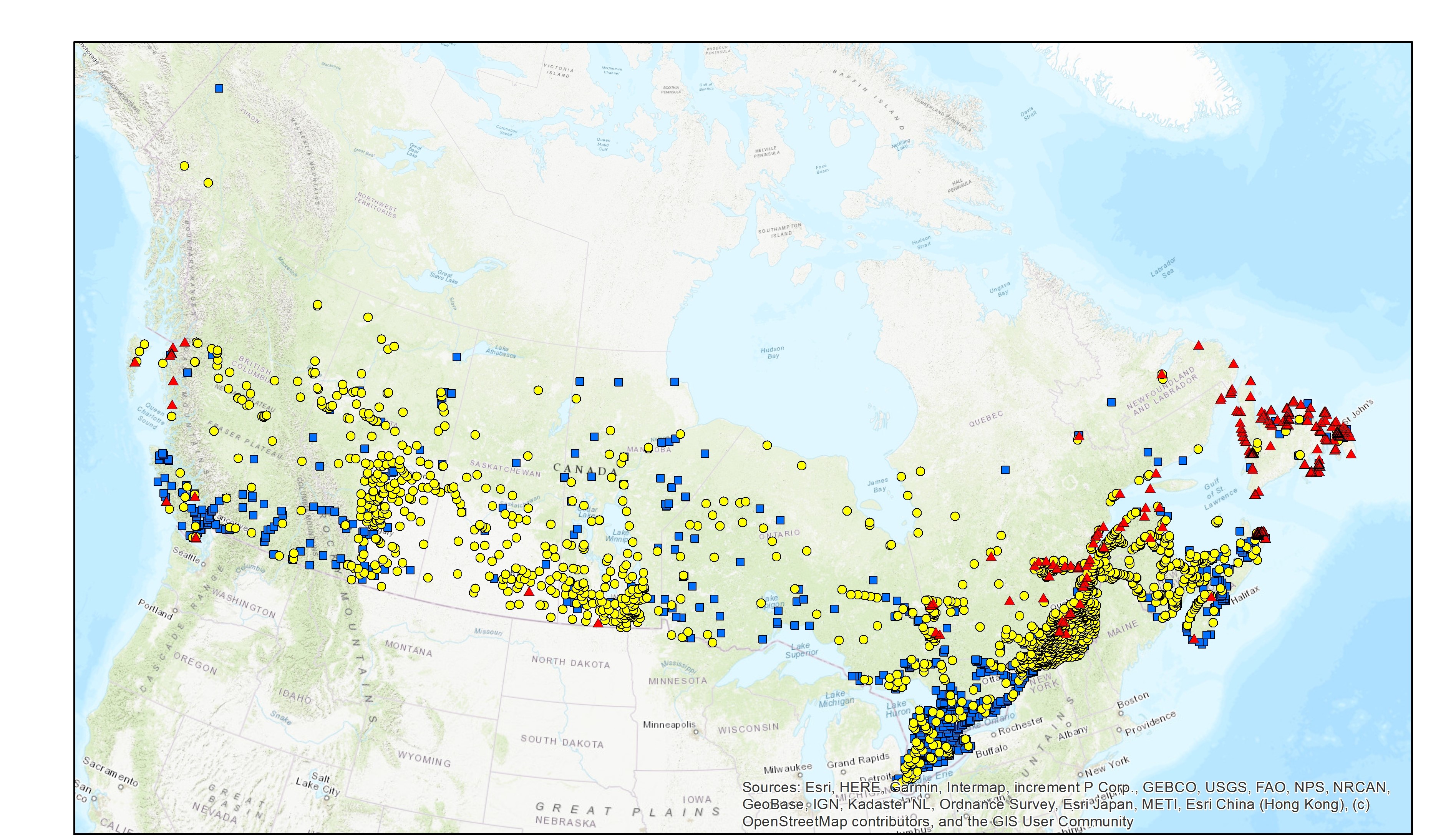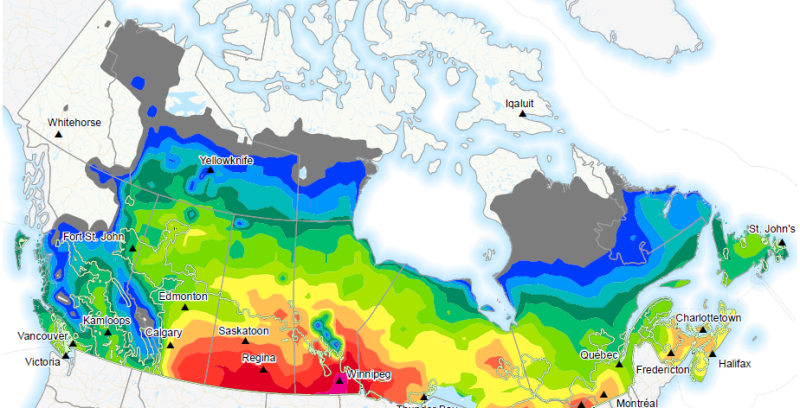RI_623
Type of resources
Available actions
Topics
Keywords
Contact for the resource
Provided by
Formats
Representation types
Update frequencies
status
Scale
-
In 1949 a magnitude 8.1 earthquake occurred on the Queen Charlotte Fault, off the west coast of the Haida Gwaii archipelago. This magnitude 7.7 scenario along the Queen Charlotte Fault is slightly different and closer to population centres than the magnitude 7.8 earthquake that occurred in 2012.
-

The Wastewater Systems Effluent Regulations (WSER), developed under the Fisheries Act, came into force in 2012 to manage wastewater releases by systems that collect an average daily influent volume of 100 cubic metres or more. The WSER also does not apply to any wastewater system located in the Northwest Territories, Nunavut and north of the 54th parallel in the provinces of Quebec and Newfoundland and Labrador. The WSER set national baseline effluent quality standards that are achievable through secondary wastewater treatment. The WSER require owners or operators of wastewater systems with combined sewers to submit an annual report on the total volume and the number of days wastewater is discharged per month via combined sewer overflow (CSO) points as a result of precipitation. The map below shows the volume of effluent (in cubic metres) discharged in a year from all CSO points situated within the collection area of a wastewater system. For the most part, the volumes provided to ECCC are estimates. Please note, a value of “999999999” in the dataset indicates that the volume data is unavailable and it does not mean that a volume of 999,999,999 m3 was released within the collection area of a wastewater system. The map is available in both ESRI REST (to use with ARC GIS) and WMS (open source) formats. For more information about the individual reporting wastewater systems, datasets are available in either CSV or XLS formats. Data from Quebec As of 2018, no combined sewer overflow volumes from Quebec municipalities are available since an equivalency agreement is now in effect. More information on the wastewater sector including the regulations, agreements, contacts and resource documents is available at: https://www.canada.ca/wastewater
-

The Fisheries and Oceans Canada ecosystem surveys are conducted annually and are a source of integrated ecosystem monitoring data. These survey data are the primary data source for monitoring trends in species distribution, abundance, and biological condition within the region, and also provide data to the Atlantic Zonal Monitoring Program (AZMP) for monitoring hydrographic conditions, along with zooplankton and phytoplankton. The surveys follow a stratified random sampling design, and include sampling using a bottom otter trawl, CTD rosette and vertical plankton tows. Data from the bottom trawl catch are used to monitor the distribution and abundance of fish and invertebrates throughout the Scotian Shelf, Bay of Fundy and Georges Bank. Cite this data as: Clark, D., Emberley, J. Data of MARITIMES RESEARCH VESSEL SURVEYS. Published January 2021. Population Ecology Division, Fisheries and Oceans Canada, Dartmouth, N.S. https://open.canada.ca/data/en/dataset/8ddcaeea-b806-4958-a79f-ba9ab645f53b
-

The Wastewater Systems Effluent Regulations (WSER), developed under the Fisheries Act, came into force in 2012 to manage wastewater releases by systems that collect an average daily influent volume of 100 cubic metres or more. The WSER also does not apply to any wastewater system located in the Northwest Territories, Nunavut and north of the 54th parallel in the provinces of Quebec and Newfoundland and Labrador. The WSER set national baseline effluent quality standards that are achievable through secondary wastewater treatment. The map below presents the wastewater system locations in Canada and the type of treatment they utilize (mechanical, lagoon or no treatment). The data is based on the information submitted to Environment and Climate Change Canada as of November 2022. Note that this layer does not represent the level of wastewater treatment or whether the system complies with the WSER. The map is available in both ESRI REST (to use with ARC GIS) and WMS (open source) formats. For more information about the individual reporting wastewater systems, datasets are available in either Excel or CSV formats at the resource listed below: “Wastewater Systems Effluent Regulations Reported Data”. Data from Quebec and Yukon The data for Quebec municipalities (after 2017) is provided to the department separately through the equivalency agreement that was finalized in October 2018. Beginning in 2015, the data reported for the Yukon is provided to the department separately through an equivalency agreement finalized in 2014. More information on the wastewater sector including the regulations, agreements, contacts and resource documents is available at: https://www.canada.ca/wastewater
-

An archive of 2D regional seismic and long period magnetotelluric data collected during 20 years of work under the LITHOPROBE project. Data are primarily onshore and cover widespread regions of Canada. Available data types include raw digital data, processed sections, and images of final sections, as well as auxiliary information required for analysis of the data.
-

Cumulative heat-energy satisfies the essential requirement of field crop growth and development towards a high yield and good quality of agricultural crop products. Agriculture is an important primary production sector in Canada. Agricultural production, profitability, sustainability and food security depend on many agrometeorological factors. Extreme weather events in Canada, such as drought, floods, heat waves, frosts and high intensity storms, have the ability to significantly impact field crop production. Agriculture and Agri-Food Canada (AAFC) and Environment and Climate Change Canada (ECCC) have together developed a suite of extreme agrometeorological indices based on four main categories of weather factors: temperature, precipitation, heat, and wind. The extreme weather indices are intended as short-term prediction tools and generated using ECCC’s medium range forecasts to create a weekly index product on a daily basis.
-

High resolution 2D/3D seismic surveys performed for the Geological Survey of Canada to advance the use of seismic methods in hard rock environments.
-
Last Spring Frost (0 °C) is defined as the average day, during the first half of the year, of the last occurrence of a minimum temperature at or below 0 °C. These values are calculated across Canada in 10x10 km cells.
-
Last Spring Frost (-4 °C) is defined as the average day, during the first half of the year, of the last occurrence of a minimum temperature at or below -4 °C. These values are calculated across Canada in 10x10 km cells.
-
Frost Day Count (-2 °C) is defined as the count of the number of days in a calendar month where the minimum daily temperature for the climate day was at or below -2 °C. These values are calculated across Canada in 10x10 km cells.
 Arctic SDI catalogue
Arctic SDI catalogue